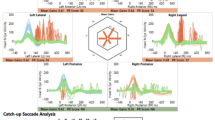Summary
Two case reports illustrate the therapeutic response of congenital nystagmus to a diet eliminating synthetic food colors, synthetic food flavors, the antioxidant preservatives butylated hydroxytoluene (BHT) and butylated hydroxyanisole (BHA), and a small group of foods thought to contain a natural salicylate radical.
A brief discussion of the hyperkinetic syndrome is offered with the proposal that a variety of neurologic and neuromuscular disturbances (grand mal, petit mal, psychomotor seizures; La Tourette syndrome; autism; retardation; the behavioral component of Down's syndrome; and oculomotor disturbances) may be induced by identical chemicals, depending upon the individual's genetic profile and the interaction with other environmental factors. It is perhaps the failure to integrate all the signs presented by the various clinical patterns with hyperkinesis or Minimal Brain Dysfunction (MBD) under a single heading that eye muscle involvement manifested as either nystagmus or strabismus has not been emphasized as part of the hyperkinetic syndrome.
Similar content being viewed by others
References
Report at the annual AMA meeting in New York, June 1973 and in June 1974 at the annual AMA meeting in Chicago.
Thousands of letters received from all parts of the United States, as well as from Canada, Australia, New Zealand and Norway have reported favorable responses to the diet for management of behavioral disturbances and learning disabilities.
National Advisory Committee on Hyperkinesis and Food Additives. Report to the Nutrition Foundation, June 1, 1975.
Conners, C. K., Goyette, Ch. H., et al. Food additives and hyperkinesis: A controlled double-blind experiment. Pediatrics58, 154–166 (1976).
Food Additives Project. Kaiser-Permanente Medical Care Program and the University of California at Berkeley. (Personal communication.)
Cook, P. S., Woodhill, J. M. The Feingold dietary treatment of the hyperkinetic syndrome. Medical Journal of Australia2, 85–90 (1976).
Goyette, Ch. H., Conners, C. K.: Food additives and hyperkinesis: A continuation of study. American Psychological Association presentation, August 1977. (To be published.)
Brenner, A. A study of the efficacy of the Feingold Diet on hyperkinetic children. Clinical Pediatrics16, 652–656 (1977).
Swanson, J., Bell, L., Kinsbourne, M.: An evaluation and a test of Feingold's dietary treatment for hyperactivity. (In press.)
Hindle, R. C., Priest, J. The management of hyperkinetic children: A trial of dietary therapy. New Zealand Medical Journal88, 43–45 (1978).
Williams, J. I., et al. Relative effects of drugs and diet on hyperactive behaviors: An experimental study. Pediatrics61, 811–817 (1978).
Shaywitz, B., et al. Abstract from 7th annual meeting of Child Neurology Society, September 28–30, 1978, Keystone, Colorado. Annals of Neurology4, 196 (1978).
Buttery, R., Seifert, R. M., Ling, L. C. Characterization of some volatile potato compounds. J. Agr. Food Chem.18, 538 (1970).
Feingold, B. F. Hyperkinesis and learning disabilities linked to the ingestion of artificial food colors and flavors. Journal of Learning Disabilities9, 551 (1976).
Chichester, D. F., Tanner, F. W., jr. Chapter 4. In: Handbook of Food Additives (Furia, T. E., ed.), p. 142. Cleveland: Chemical Rubber Company. 1968.
White, Handler, Smith, Stetten Principles of Biochemistry, p. 776. New York: McGraw-Hill. 1954.
Author information
Authors and Affiliations
Rights and permissions
About this article
Cite this article
Feingold, B.F. Dietary management of nystagmus. J. Neural Transmission 45, 107–115 (1979). https://doi.org/10.1007/BF01250086
Received:
Issue Date:
DOI: https://doi.org/10.1007/BF01250086




